|
|
Nine Byzantine churches in Troodos Mountains are included in official UNESCO list of World Heritage. These are: Stavros tou Agiasmati, Panagia tou Araka, Timiou Stavrou at Pelendri, Agios Nikolaos tis Stegis, Panagia Podithou, Panagia tis Asinou, Agios Ioannis Lampadistis, Panagia tou Moutoulla and Archangelos Michail at Pedoulas.
Impressive Troodos mountain range with its idyllic forests stretches across most of western side of Cyprus offering cool sanctuary in summer and opportunities for sports in winter. Famous mountain resorts divine Byzantine monasteries and churches perched on mountain peaks or nestling in its valleys, as well as picturesque mountain villages clinging to terraced hill slopes make up the splendour of Troodos.
The area has been known since ancient times for its mines and in Byzantine Period it became a prominent center of Byzantine art, as churches and monasteries were built in the mountains, far away from the threatened coastline.
Four main areas, each having its own character and charm are found on the Troodos mountain range. These are:
- Pitsylia to the East of Mount Olympos
- Solea
- Marathasa Valley to the North of Mount Olympos
- Krasochoria,"wine villages" to the South (Northwest of Lemesos district).
These areas are easily accessible from either Lemesos or Lefkosia. Actual Troodos area is found around Mount Olympos (height 1951 meters).
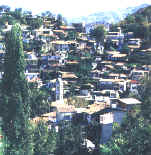
Mountain village, Troodos
Places of Interest:
Pitsylia
Pitsylia area lies on the eastern slopes of Troodos mountain range. Picturesque villages cling to mountainside amid vineyards, orchards of almond and hazelnut trees and an astonishing array of wild flowers. Pitsylia area can be reached either from Lemesos or Lefkosia. From Lemesos one takes Lemesos-Agios Theodoros-Agros road, or Lemesos-Kato Amiantos-Karvounas-Kyperounta road. From Lefkosia one passes through Palaichori-Agros, or through Kakopetria-Karvounas-Kyperounta.
Louvaras
28 km North of Lemesos, on the South of Troodos range, off Lemesos-Agros road
In the center of the village is the small church of Agios Mamas, built in 1455, with mural paintings signed by Philip Goul.
Agros
45 km North of Lemesos, through Agios Theodoros
Agros is the center of the district. A 19th century church now stands on the site of monastery of Panagia Eleousa, founded by monks from Constantinople in 9th century.
Palaichori
45 km South of Lefkosia, on Lefkosia-Agros-Lemesos road, and 15 km from Agros
Church of "Metamorfosis tou Sotiros", Transfiguration of Saviour, is an early 16th century chapel on the hill, overlooking the beautiful old village. Its interior is completely painted with one of the most accomplished series of murals of post-Byzantine period in Cyprus. Church of Panagia Chrysopantanassa built in 16th century, contains wall paintings. It is the main church of the upper village.
Palaichori has an Ecclesiastic Museum, which houses icons and other consecrated vessels from various churches of the village, as well as a Struggle Museum in a house, which once served as a hideout for heroes of the EOKA Independence Struggle (1955-59). Impressive monument of "Cypriot Mother" dominates the entire area.
Platanistasa
Stavros tou Agiasmati
Platanistasa village, 15 km from Agros, 30 km off Lefkosia-Astromeritis road, turning left before Peristerona village
A 15th century church, lying about 3 km outside this charming old village, retains the most complete cycles of mural paintings of the second half of 15th century in Cyprus. Visitors can ask for key from the village priest.
Lagoudera
Panagia tou Araka
Lagoudera village is 15 km from Agros or off the Kakopetria-Troodos-Lemesos road (Karvounas crossroad).
The 12th century church situated just outside the village has frescoes, which are some of the finest of the late Comnenian style (c1192) prevailing throughout Greece, the Balkans and Russia. Together with Asinou church and that of Agios Nikolaos its Stegis, it is considered to be one of the most important Byzantine churches on the island. Visitors can ask for the key and be escorted by the priest who is to be found in the premises next to the church.
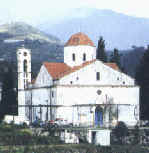
Agros village, Pitsylia
Kourdali
Church of Panagia Chrysokourdaliotissa
A three-aisled church with a steep pitched roof and flat roof tiles. It was built in 16th century as a monastery church, dedicated to Virgin Mary and founded by deacon Ioannis Kourdalis, according to the inscription. Wall paintings are of the same period, and some have Western influences. Iconostasis is a beautiful example of wood sculpture of 16th-17th centuries.
Spilia
Eliomylos (Olive press)
A one-room stone building with a pitched roof. 19th century wooden installation of the press, as well as the stone-olive mill, together with the millstones, is all very well preserved. Various objects and tools used for production of oil are on display. Olive Press was repaired in 1995 by Department of Antiquities. Visitors should ask for key from Association of Overseas Cypriots and Friends of Spilia-Kourdalon in a building nearby.
Pelendri
Timiou Stavrou
3 km below Kato Amiantos, off Karvouna-Lemesos road, 32 km from Lemesos
Once the property of Jean de Lusignan, son of the Lusignan King of Cyprus, Hugh IV. There are two interesting churches; 14th century church of Timiou Stavrou, Holy Cross, with beautiful wall paintings and Church of Panagia Katholiki in the center of the village which dates to the early 16th century, with paintings in Italo-Byzantine style.
Kyperounta
Church of the Holy Cross houses Ecclesiastic Museum, which contains icons and religious artifacts belonging to the village churches. ). It also has a garden with traditional plants and herbs. To arrange a visit, please call (05) 53 22 52.
Solea Valley
On the main Lefkosia-Troodos road, 56 km from Lefkosia and 56 km from Lemesos (via Kato Amiantos and Saittas)
Solea valley is famous for its apples, its Byzantine churches and its picturesque villages. Kakopetria and Galata villages, preserving much of their traditional folk architectural character, are popular hill resorts. Other charming villages in the valley are Evrychou, Flasou and Korakou.
Kakopetria
Agios Nikolaos tis Stegis
Church of Agios Nikolaos tis Stegis, 'Saint Nicholas of Roof, stands about 5 km to the North of the village and once belonged to a monastery. It is completely painted with murals dating from 11th to 17th century and is considered one of the most interesting Byzantine churches on the island. Church took its name from the steep pitched wooden roof, which was built to protect it from climatological conditions. The small 16th century church of Panagia Theotokos, off the main road, has retained about half of its murals. Church of Agios Georgios Perachoritis, on the East of the village, has some very original wall paintings, belonging to the first quarter of 16th century. The old quarter of the village has been declared a protected area and traditional houses have been restored.
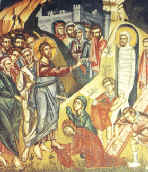
The Raising of Lazarus
Portable wooden icon, 16th century
Sotira
Kykkos Monastery
20 km West of Pedoulas village
The most famous and richest monastery in Cyprus. Founded in 1100 and dedicated to Virgin Mary, it possesses one of the three surviving icons ascribed to Saint Luke. The icon, covered in silver gilt and enclosed in a shrine of tortoiseshell and mother-of -pearl, stands at the front of the iconostasis. The first President of Cyprus, Archbishop Makarios III served here as a novice. At his own wish, he was buried at Throni, 3 km West of Monastery and not far from his native village of Panagia. Religious fairs are held at Kykkos on 15th August and 8th September.
The Museum of Kykkos houses an important collection of consecrated vessels and Cypriot antiquities.
Trooditissa Monastery
5 km Northwest of Platres, 40 km from Lemesos, on Platres-Prodromos road
This beautiful monastery was originally founded in 13th century. Present church dating from 1731,contains many valuable icons, including a priceless icon of Virgin Mary plated with silver-gilt from Asia Minor. A large religious fair is held in the grounds on 15th August. The monastery is closed for visits.
Mesa Potamos Monastery
Deserted monastery near Platres in an idyllic setting, with a nearby waterfall.
Krasochoria
Tel: (05) 24 32 23 and 24 33 47
Area of krasochoria, meaning 'wine villages', is found on the South side of Troodos range. Traditions are kept alive in these villages, where the cultivation of vineyards and wine making are still the main occupation of inhabitants. This is the area, which produces the famous local dry red wine. Main villages in the area are Omodos, Arsos, Pachna, Koilani and Vasa. The area is reached from the Lemesos-Pafos road, turning right after Erimi village or from the Lemesos-Platres road.
Important villages of region include Omodos, Vouni, Pachna and Arsos, which has an interesting little Folk Art Museum.
Omodos
11 km Southwest of platres
A wine producing village, once the property of Sir John De Brie, Prince of Galilee, with Monastery of Stavros, 'Holy Cross', standing by stone-paved square. Monastery contains old icons, excellent woodcarving and other ecclesiastical objects of interest, as well as a small National Struggle Museum. A traditional wine press known as ‘Linos’ has been restored in an old house. A festival is held in the village every August, and there is a large religious fair on 14th of September.
Foini
4 km west of Platres
Famous for its pottery and its loukoumi sweet. Visitors can see Pilavakeion private pottery collection.
Koilani
1.5 km Southwest of Pera Pedi, off Lemesos-Troodos road
An attractive wine-producing village. Two kilometers from the village is single aisled vaulted church of Agia Mavri, typical of 12th century architecture with murals of the late 15th century. Village has a local Ecclesiastical and Viticulture museum.
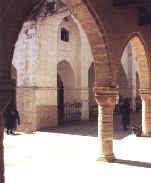
Stavros Monastery
Omodos
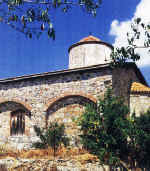
Timios Stavros Church
Pelendri
|
|





